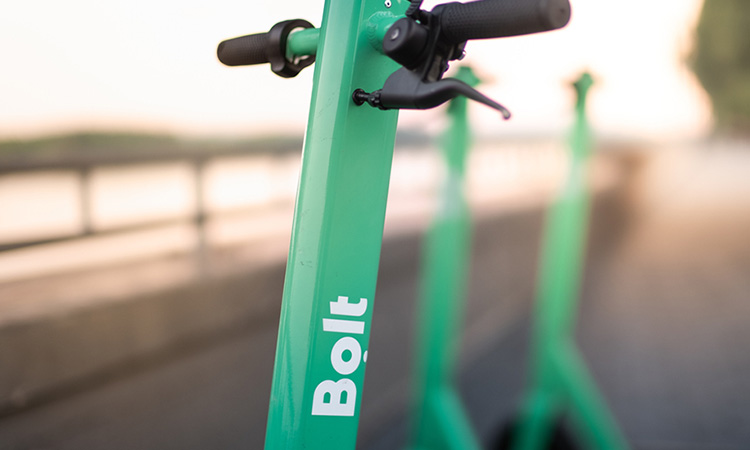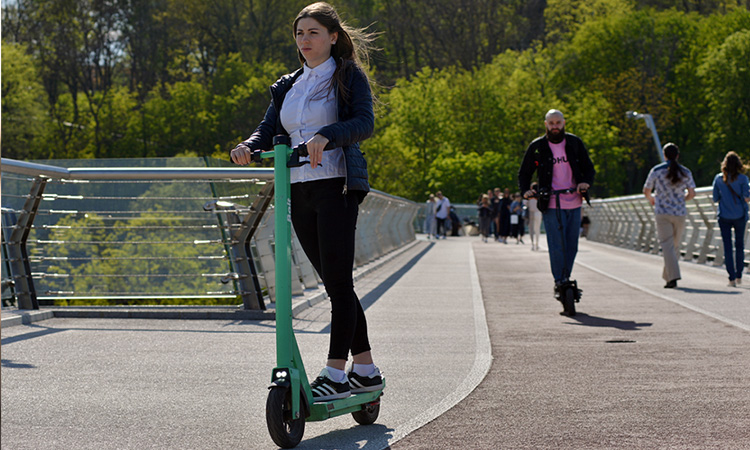Redefining safety standards: Bolt’s innovative approach to micro-mobility safety
- Like
- Digg
- Del
- Tumblr
- VKontakte
- Buffer
- Love This
- Odnoklassniki
- Meneame
- Blogger
- Amazon
- Yahoo Mail
- Gmail
- AOL
- Newsvine
- HackerNews
- Evernote
- MySpace
- Mail.ru
- Viadeo
- Line
- Comments
- Yummly
- SMS
- Viber
- Telegram
- Subscribe
- Skype
- Facebook Messenger
- Kakao
- LiveJournal
- Yammer
- Edgar
- Fintel
- Mix
- Instapaper
- Copy Link
Posted: 8 August 2023 | Dmitri Pivovarov - Bolt | 1 comment
Dmitri Pivovarov, Vice President for Rentals at Bolt, shares his vision for the future of micro-mobility safety and discusses how Bolt’s innovative solutions are re-shaping the way that people move around in cities.


Credit: Bolt
Can you provide an overview of Bolt’s tandem riding prevention system and how it contributes to safety in the micro-mobility industry?
Cities typically have a shortlist of matters that they like to see addressed. These are primarily safety and parking, with tandem riding often being included within the former bracket. This is well-aligned with Bolt’s priorities – our in-house teams work on safety and city-oriented features that bring the most value to the city and its citizens. We were the first to roll-out a tandem riding detection and prevention system as a result.
This technology predominantly relies on the scooter’s in-built accelerometer and historical data. If it detects a sudden change in mass compared to previous rides on the same account, it’s likely that the scooter isn’t being used by just the account owner. If this happens, we educate the user about the risks of tandem riding.
We saw a 30% drop in tandem rides in Munich in just five months and a 76% drop in seven months”
Evidence suggests this works. For example, we saw a 30% drop in tandem rides in Munich in just five months and a 76% drop in seven months.
Fortunately, we have seen our other safety features to be similarly effective. For example, ParkAssist +, which uses artificial intelligence (AI) and geo-location technology to check if a scooter is responsibly parked, resulted in a 69% decrease in incorrectly parked scooters in Stockholm in just six weeks.
The reckless rider score is an interesting concept. Could you explain how Bolt evaluates a rider’s behaviour and how this score helps in promoting responsible and safe riding habits?
Since we know that education goes a long way to solving the problem… we feel that an iterative three-step disciplinary approach is appropriate”
The reckless rider score is calculated from dozens of inputs that each vehicle measures, which includes tandem riding, irresponsible parking, repeated abrupt braking and skidding. Each of these behaviours is marked in the system with points, with the user’s riding behaviour being evaluated every five rides.
Since we know that education goes a long way to solving the problem, and that many people use our micro-mobility services as a viable transport mode, we feel that an iterative three-step disciplinary approach is appropriate.
The first step is education and prompting the user to attend our Bolt Rider Academy. The second step – if the score isn’t improved within the next five rides – is reducing their speed to 15 km/h. If the score isn’t improved within the next five rides after that, the third step is a one-week suspension. The second and third step will be repeated until the score is improved.


How does Bolt’s ambient sound feature work? Could you elaborate on its purpose and how it helps in alerting pedestrians and improving safety in urban environments?
One benefit of a world with far less reliance on the private car is the significant reduction of noise pollution. However, this shouldn’t be to the detriment of pedestrian safety, including those with visual impairments. Consequently, we have developed a specific sound for our e-scooters.
Despite the increased popularity of battery-powered transport modes, it can still be loud out there, so we have partnered with the Italian Union of the Blind and Visually Impaired (Unione Italiana dei Ciechi e degli Ipovedenti) in Bologna to design a sound that is distinctive and easily recognisable by those with visual impairments, helping them to navigate safely in an environment that might otherwise pose challenges. By implementing this sound, e-scooters can operate quietly and harmoniously with pedestrians safely, creating a more inclusive and environmentally friendly transportation system.
Can you share some examples of the year-on-year improvements that Bolt has achieved in terms of safety as a result of the implemented innovations, and what specific metrics or indicators can demonstrate these improvements?
We’re proud to say that 99.97% of Bolt scooter and e-bike rides finished without any safety incidents in 2022″
The amount of safety and parking features that we’re able to offer to cities and citizens has improved to such a great extent that we now have a number of suites in our armoury to ensure that micro-mobility can work for everyone. Our Advanced Mobility Intelligence System includes a cutting-edge smart module with enhanced Internet of Things (IoT), and a built-in processor allows us to analyse data in real-time. Our Smart Parking 360 solutions package includes our in-house AI, which can detect when a scooter is parked irresponsibly or at risk of falling over.
Consequently, we’re proud to say that 99.97% of Bolt scooter and e-bike rides finished without any safety incidents in 2022. However, cities and citizens rely on our micro-mobility services to such an extent that we’ll always be working on improving. That’s why, in early 2023, we launched a scooter safety pledge, committing to working with cities to improve safety for our micro-mobility services and to educate customers on safe riding.
In your opinion, what are the most significant challenges in ensuring safety within the micro-mobility industry, and how is Bolt addressing these challenges?
Data says that, on the rare occasion an e-scooter is in an accident, it typically isn’t with another light vehicle or a pedestrian but a car”
Data says that, on the rare occasion that an e-scooter is in an accident, it typically isn’t with another light vehicle or a pedestrian, but a car. This points to the considerable need for designated infrastructure. Similar to us using data to determine the locations that make for the most productive but least invasive deployment spots, we also share data with cities as to where and how our services are used. This, too, can inform where designated infrastructure can be most productive and least invasive.
It’s worth noting that these insights aren’t just limited to e-scooters, since we offer several other transport modes, including e-bikes, ride-hailing and car-sharing. This richness of data shows the true picture and is unique to Bolt.
Another enemy of safety is complacency. This can arrive in markets where a tender restricts competition by limiting the number of operators. Not only does this mean pricing increases (meaning riders may feel forced to ride recklessly to keep their bill low), it also means that safety innovations slow down. However, a scenario which allows for multiple operators encourages each to constantly adapt and upgrade their scooters and safety offering because they want to stay on top of the competition.


Safety is a crucial aspect of any mobility service. How does Bolt ensure that its safety measures and innovations are effectively communicated to users?
Our technology that addresses the common issues has evolved enormously. If someone parks badly, rides irresponsibly, tandem rides – we know. This has and will continue to naturally encourage good behaviour and discourage bad behaviour. The fact that we can respond to all types of behaviour on the same portal that customers use to engage with our services – our app – is also extremely efficient.
On a less technical level, we also take measures to educate riders outside of the app. This ranges from online videos featuring Hell’s Angels encouraging customers to wear a helmet, to physical safety courses, even to making art out of well-parked scooters.
Bolt operates in various cities and countries worldwide. How does the company adapt its safety initiatives and innovations to different regulatory environments and cultural contexts, and are there any specific challenges or considerations when implementing safety measures in different regions?
It’s all about predicting and analysing how our services are used, and how we can bring maximum value and minimum inconvenience. Of course, this is done with cities pre- and post-deployment as, naturally, they know their citizens best. We have a set of safety features which we typically roll-out in all cities, but we can take an even more bespoke approach when it’s deemed necessary.
For example, we can make our test – which measures if someone is fit to ride a micro-mobility service – more strict when citizens are predicted to consume more alcohol than normal, like at a festival. We can also leverage our operations and multimodality to improve the safety and efficiency of transport; for example, by deploying more scooters in hotspots where attendees are likely to pick up a scooter to travel to an event, and then offering a discount for our ride-hailing service should they fail our cognitive reaction test after the event.
Looking into the future, what are Bolt’s plans for further improving safety in the micro-mobility industry?
We’re really proud of our new scooter model, Bolt 6. The days of an e-scooter being as rudimentary as two wheels and an electric battery are long gone. Bolt 6 already has class-leading levels of intelligence, but the really exciting thing is that it’s going to get even more intelligent over time (which is lucky, since its lifespan is also class-leading at eight years).
This is because our Advanced Mobility Intelligence System uses over 100 sensor inputs and on-board microprocessors to analyse every ride. Not only does this make for a safer ride, it also means the scooter systems provide up-to-date information to Bolt’s staff and automatically plans its repairs and maintenance schedule to make sure all the vehicles are technically safe and sound.
Furthermore, designing a scooter in-house gives us full control of software and hardware, enabling us to continuously upgrade the safety features that we provide to riders and pedestrians.


Related topics
Micro-mobility, Mobility Services, Passenger Experience, Vehicle & Passenger Safety
Related modes
Bikes & Scooters
Related organisations
Bolt
Related people
Dmitri Pivovarov








The explanations in your article are good. Thank you for sharing it.